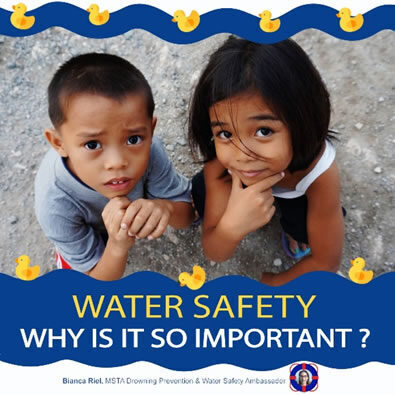
The definition of water safety is the
- procedures
- precautions
- policies associated with safety in, on, and around bodies of water (pool, ocean, lake, river, bathtub, bucket, pond etc), where there is a risk of injury or drowning
Water Safety has 3 important layers to reduce the risk of drowning in any swimming environment. The below layers should give you a summary of reasons why water safety is important.
1. Swimming skills
- Learn to swim! The most effective way to prevent drowning is to learn how to swim. Swimming lessons are proven to reduce the risk of drowning, by up to 88%. If you know how to float on your back, you can scream for help. Drowning is mostly silent and you may sink to the bottom and nobody realizes it.
- Being able to swim means: enter and exit the water safely, float and tread water for 1 minute, turn over and turn around in the water, swim at least 25 meters.
2. Be smart in, around, near water
- Rule # 1 never swim alone. Always dedicate a water watcher or have a buddy when you go swimming and check regularly on each other.
- Never leave children unsupervised near a pool, hot tub, or natural body of water. Just because your child can swim, it doesn’t mean you don’t need to supervise your child anymore. Olympic swimmers drown due to many reasons, that’s why its mandatory to always have a buddy when you go swimming.
- Know how to call for help. Never make jokes if you don’t need help, they might not help you next time, if you need help.
- Understand the risks of each water you are in, before you go inside, look for hazards. A pool has different risks than open water or a river.
- Always feet first. Know your water depth it might be shallow. Watch out for animals inside the water, which can hurt you.
- If you are on a boat, for fishing, a cruise, a ferry, sailing always wear a life jacket.
3. Know how to help others
- If you are with children or weak swimmers in the water, stay close to them and supervise them at all times. It takes less than 30 seconds a child drowns.
- Learn cardiopulmonary resuscitation (CPR). Parents and child care providers should know CPR and First Aid.
- Know the signs when someone is drowning. Drowning goes fast and is mostly silent.
- It’s important to know ways to assist safely a drowning person, without bringing yourself into danger.
- If you can’t swim or are not trained on how to help a drowning person especially in open water, never go inside to help. “Reach or throw, don’t go.”
- Have an emergency number on your phone in case of an incident.
Why is water safety so important?
All 3 layers are precautions to prevent drowning!(written by Bianca Riel, MSTA Drowning Prevention & Water Safety Ambassador
